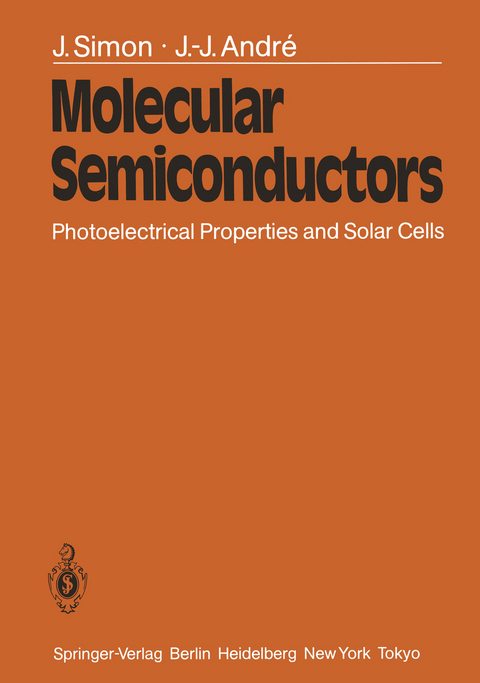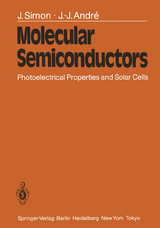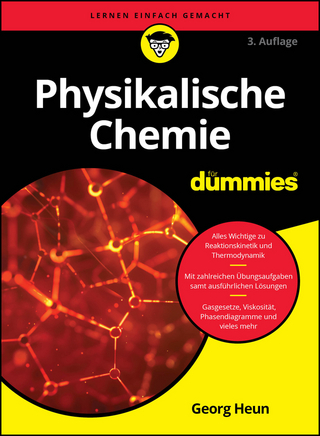Molecular Semiconductors
Springer Berlin (Verlag)
978-3-540-13754-2 (ISBN)
- Keine Verlagsinformationen verfügbar
- Artikel merken
I Basic Notions of Solid State Physics.- I.1 Dark Conductivity: Generalities.- I.2 Conduction in Metals: Drude and Sommerfeld Models.- I.3 Band Model of Conduction.- I.4 Limitations to Band Theory.- I.5 Hopping and Tunneling Mechanisms of Charge Migration.- I.6 Charge Carrier Trapping Processes.- a Molecular Crystals.- b Polymers.- II Photoelectric Phenomena in Molecular Semiconductors.- II. 1 Light Absorption.- II.2 Energy Migration in Molecular Materials.- a Mechanisms of Energy Migration.- b Effect of Traps.- II.3 Photogeneration of Charge Carriers.- II.4 Semiconductor Junctions.- a p-n Junctions: Formation and Electrical Properties.- b Schottky Junctions: Semiconductor-Metal Contacts.- c Insulator-Metal Contacts.- II.5 Photovoltaic Effect.- a Molecular Solar Cells: Classical Formulation.- b Molecular Solar Cells: Localized States Formulation.- c Effect of Surface States.- d Characterization of Junctions by the Capacitance Method.- III Metallophthalocyanines.- III. 1 Syntheses and Physico-Chemical Properties.- a Syntheses.- b Structure and Morphology.- c Spectroscopic Properties.- d Photoelectron Spectroscopy.- e Oxidation-Reduction Properties.- f Electron Spin Resonance Measurements (ESR).- III.2 Dark Electrical Properties.- a Energy Band Structures.- b Electrical Properties: Intrinsic Case.- c Determination of the Trapping Levels.- d Doping of PcM by O2.- e Doping of PcM by other Doping Agents.- III.3 Photovoltaic Effect and Solar Cells.- a Photoelectrical Properties.- b Photovoltaic Effect: Generalities.- c Junction in the Dark.- d Junction Studies under Illumination.- e Effect of Doping on the Performances of Molecular Solar Cells.- f Solar Energy Conversion Efficiencies of Molecular Solar Cells.- IV Poly acetylene.- IV. 1 Synthesis and Physico-Chemical Properties of Polyacetylene.- a Synthesis.- b Morphology.- c Molecular Weight and Length of the Conjugated Sequences.- d Stability of Polyacetylene and Effect of O2.- e Isomers.- f Crystalline Structures.- IV.2 Theoretical Properties.- a Origin of the Band Gap.- b Band Structure.- c Bond Length Alternation Defects in Polyenes: the Solitons.- IV.3 Properties of Doped Polyacetylene.- a Dopants and Doping Processes.- b Structural Features.- c Optical Properties.- d Magnetic Properties.- IV.4 Transport Properties of Polyacetylene.- a Conduction Mechanisms at Low Doping Levels.- b Semiconductor-Metal Transition.- c Metallic Domain.- d Comparison of the Models with the Experimental Results in the Low Dopant Concentration Domain.- IV. 5 Photoelectric Properties and Solar Cells.- a Luminescence and Photoconductive Properties of Cis- and Trans- Poly acetylene.- b Junctions Properties and Molecular Solar Cells.- V The Main Other Molecular Semiconductors.- V. l Aromatic Hydrocarbons and Graphite.- V.2 Metallo-Organic Derivatives.- V.3 Charge Transfer Systems.- a Different Types of Charge-Transfer Systems.- b Charge Distribution.- c Charge-Transport Properties.- d Tetrathiofulvalene-tetracyanoquinodimethane (TTF-TCNQ) and Related Complexes.- e (Tetramethyltetraselenofulvalene)2-X and Related Radical-Ion Salts.- V.4 Polysulfurnitride and Polydiacetylene.- V.5 Polymethines.- V.6 Polymeric Conjugated Systems.- a Polyphenylene and Related Materials.- b Substituted Polyacetylenes, Phenylacetylene.- c Pyrolyzed Polyacrylonitrile.- d Polypyrroles.- V.7 Molecular Solar Cells.- a Squaric Acid and Merocyanine.- b Aromatic Derivatives.- c Aromatic Liquid Crystals.- d Chlorophylls and Porphyrins.- e Polymeric Systems.- Conclusion.- References.
| Erscheint lt. Verlag | 1.4.1985 |
|---|---|
| Zusatzinfo | XIV, 290 p. |
| Verlagsort | Berlin |
| Sprache | englisch |
| Gewicht | 678 g |
| Themenwelt | Naturwissenschaften ► Chemie ► Physikalische Chemie |
| Naturwissenschaften ► Physik / Astronomie ► Thermodynamik | |
| Technik ► Elektrotechnik / Energietechnik | |
| Schlagworte | defects • Elektrochemie • Halbleiter • HC/Chemie/Physikalische Chemie • optical properties • Photochemie • semiconductor • Solarenergie • Solarenergie / Sonnenenergie • Solid state physics • spectroscopy • tunneling |
| ISBN-10 | 3-540-13754-8 / 3540137548 |
| ISBN-13 | 978-3-540-13754-2 / 9783540137542 |
| Zustand | Neuware |
| Informationen gemäß Produktsicherheitsverordnung (GPSR) | |
| Haben Sie eine Frage zum Produkt? |
aus dem Bereich




